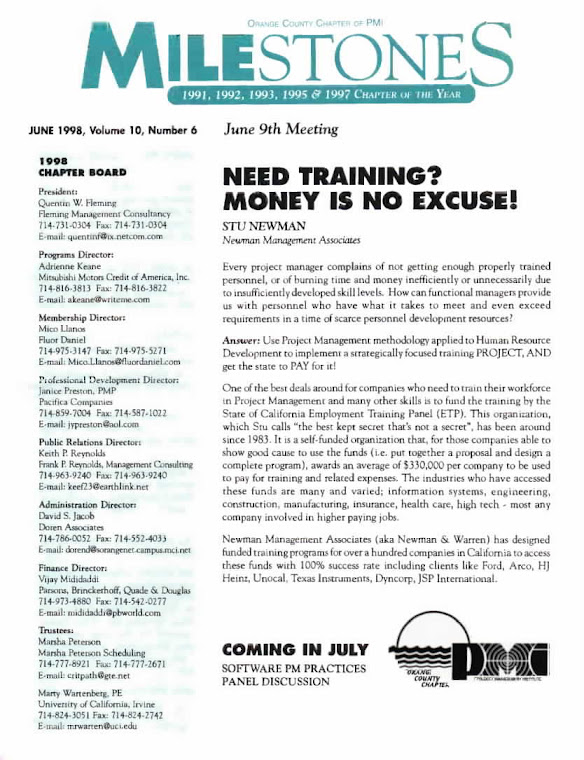5 STEPS TO EFFECTIVE BUSINESS MEETINGS
(MICHAEL LEE SMITH 01/31/06)
Can’t get any work done because of all those meetings? Conducting meetings is a skill that is essential to be an effective manager.
Do you cringe when you receive a meeting announcement, or do you feel guilty when you have to send such an announcement yourself?
You might not be able to affect the meetings to which you are invited. But you can ensure that your meetings are effective -- which means that the meeting produces results.
There are five simple steps you can follow to ensure your meetings are effective.
Step 1: Only hold meetings when necessary
Step 2: Invite only those who need to be there
Step 3: Prepare and send an agenda in advance
Step 4: Lead the meeting
Step 5: Document and follow up on meeting decisions and task assignments
If you follow these five steps your meetings will consistently produce the results you need.
Typically managers spend anywhere from 1/3 to 3/4 of their time in meetings. In one company I worked with, managers spent twelve hours a week in meetings -- that’s a day and a half each week. The average meeting was two hours long. They hated meetings.
3/4 had no objective
2/3 produced few results
1/2 started late
2/3 of participants were not prepared.
Let’s consider the five steps in more detail.
Step 1: Only hold meetings when necessary
You shouldn’t hold a meeting when what you really need is a fast decision. Make a phone call or send an email instead.
You shouldn’t hold a meeting when you know the division manager(s) won’t be available -- that obviously wouldn’t be an effective meeting.
Don’t hold a meeting when the cost of the meeting is more than the benefit of having a meeting. The cost is nothing more than the hourly rate of all the participants times the length of the meeting.
- You should hold a meeting when you need the synergy that comes from participant interaction.
- You should hold a meeting when you need to produce results that can only come from getting the participants together.
You should hold a meeting to gain acceptance of a decision, a program or an idea.
Finally, you should hold a meeting when you need to produce results that can only come from getting the participants together.
Step 2: Only invite those who need to be there
How many times have you been invited to a meeting and then discovered that you didn’t really need to be there?
You should include all those who will be charged with implementing a decision or who will be affected by the decision.
This doesn’t mean you invite hordes of people. Meetings are more likely to be ineffective (and really hard to control) if you have more than 8-12 participants. Fewer rather than more participants will benefit your meeting.
You can always send minutes of the meeting to those you think have a need to know but don’t really have to be there. Minutes are just written documentation of the meeting’s deliberations, decisions, and task assignments.
Step 3: Prepare and send an agenda in advance
The agenda should have objectives, the amount of time each subject is allotted, and what the participants should do to be ready to fully participate in the meeting.
You send it in advance so participants can come prepared and not “speak off the top of their heads” about the meeting topics; which will happen, if there is no advance agenda and request for prior preparation.
Step 4: Lead the meeting
It’s your meeting. You are in charge. After all, it’s you who will be held responsible for ensuring the meeting produces the needed results.
To lead the meeting you should follow the agenda, manage the time and manage the participation. It’s up to you to keep everyone on-topic by continually referring to the agenda’s objectives.
You keep control of the meeting by summarizing what’s been said, by encouraging those who don’t speak up to participate, and by NOT allowing those annoying side conversations that often occur.
Another way to control the meeting is to post the agenda and then check off the topics as they are completed. In addition, you can write decisions on a flip chart or whiteboard as they are made. Then, before you go to the next topic, you ask if everyone agrees. Don’t assume silence means agreement or assent -- it’s just silence. Get everyone to agree out loud.
Step 5: Document and follow up on meeting decisions and assignments
You should take notes or minutes (or assign someone to do so). Minutes of a meeting are just written documentation needed for reference to be sure you don’t have to make the same decision again at a later date, or to communicate meeting results to others.
Minutes are also a tool to follow up task assignments that have been accepted by participants. The minutes should indicate who will do what, and by when.
Lastly, to develop and maintain your reputation as an effective meeting leader you should start and end on time.
Remember that company I mentioned earlier? After training in how to conduct effective meetings:
90% of the meetings had objectives
90% of the meetings used agendas
90% of the meetings produced results
and almost all started and ended on time.If you follow these five steps, you will control your meetings instead of your meetings controlling you.
Tuesday, February 26, 2008
Subscribe to:
Post Comments (Atom)




No comments:
Post a Comment